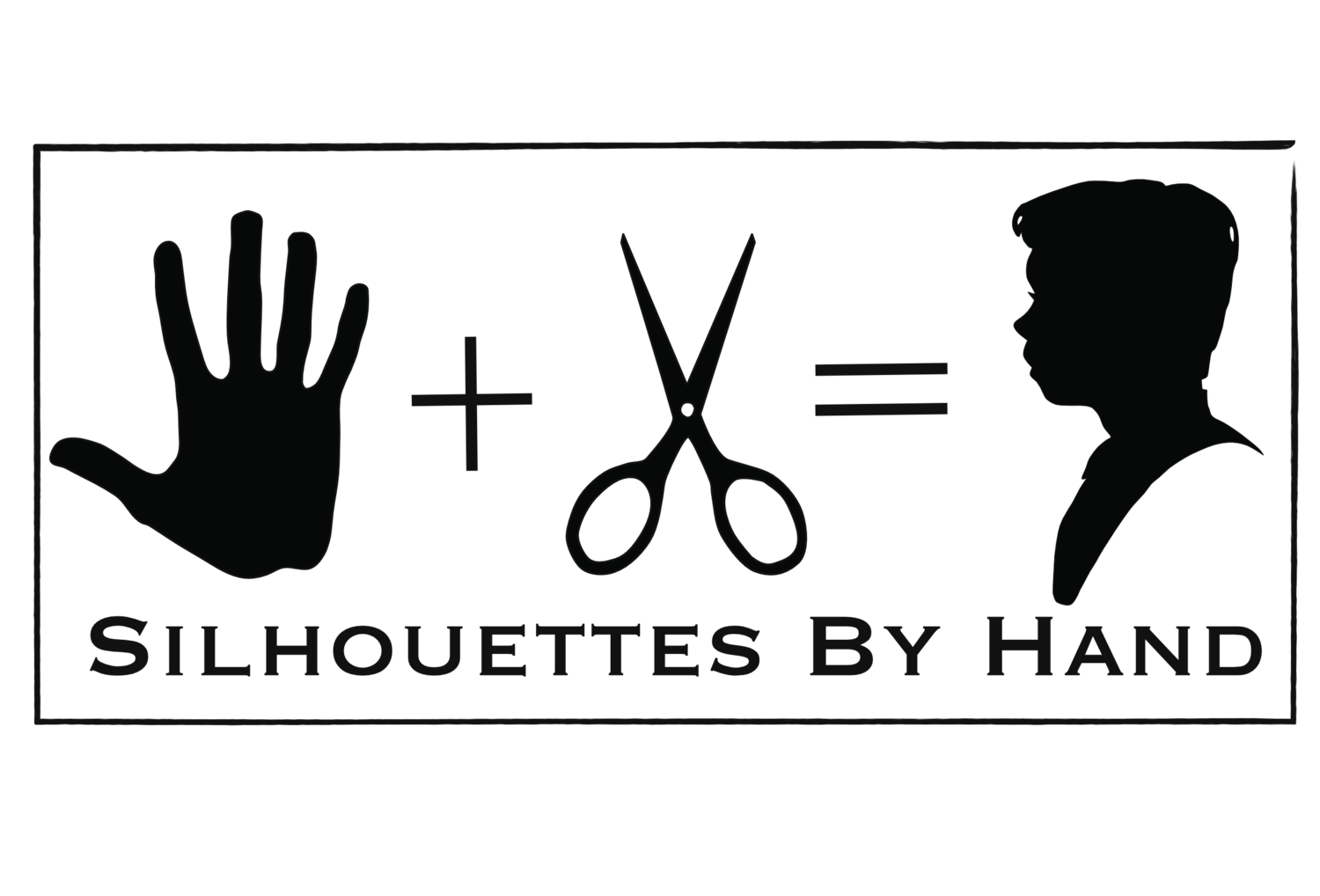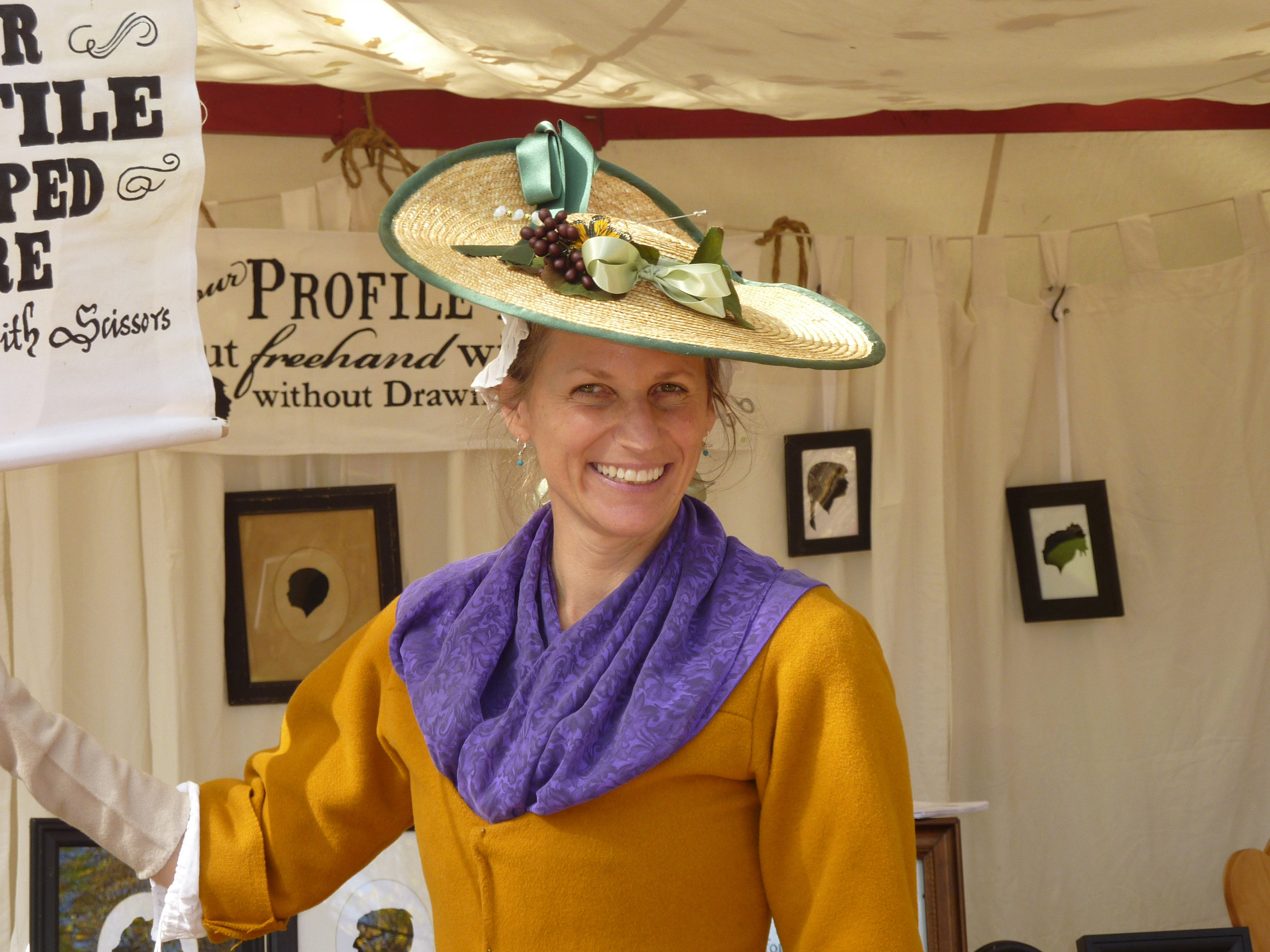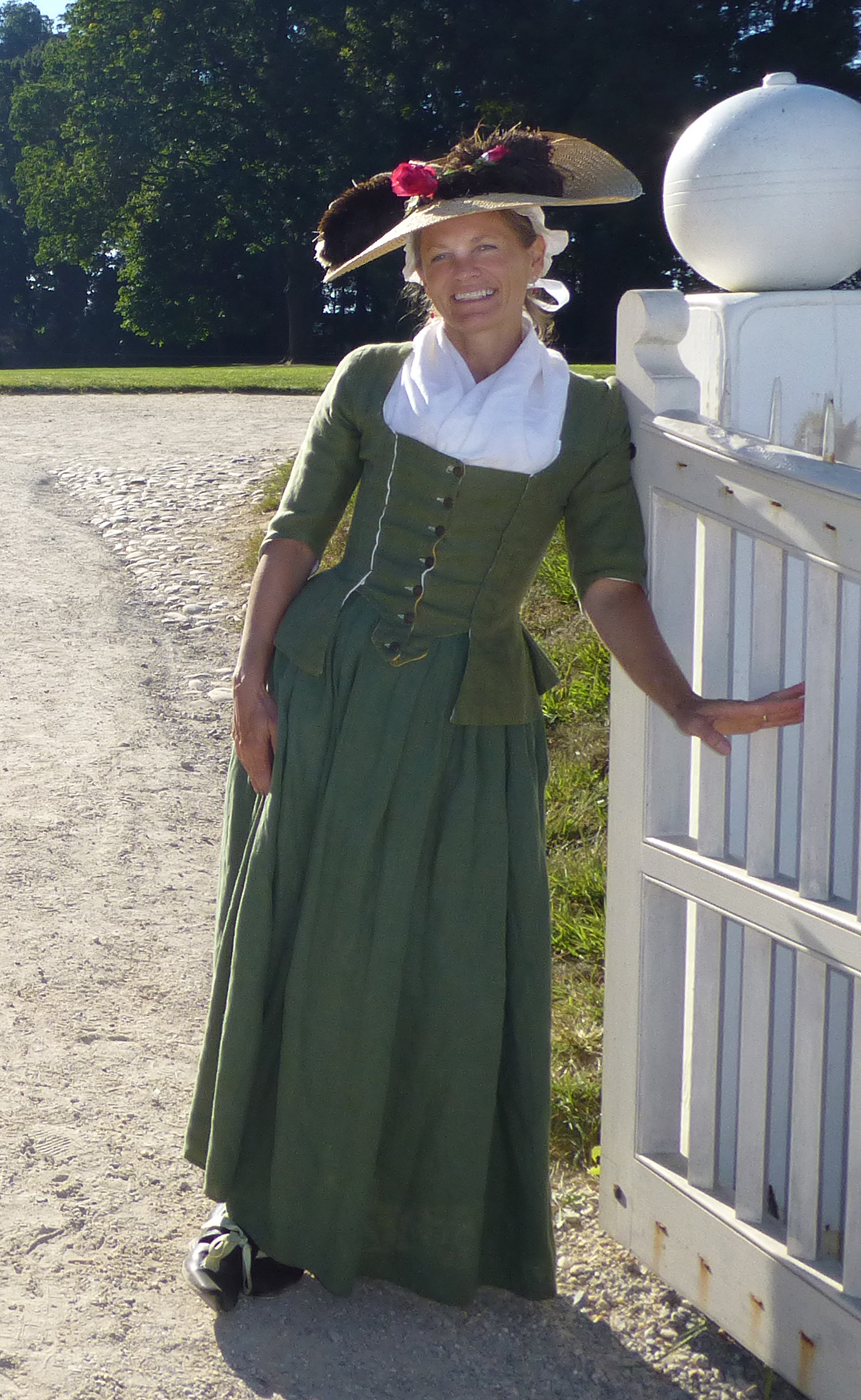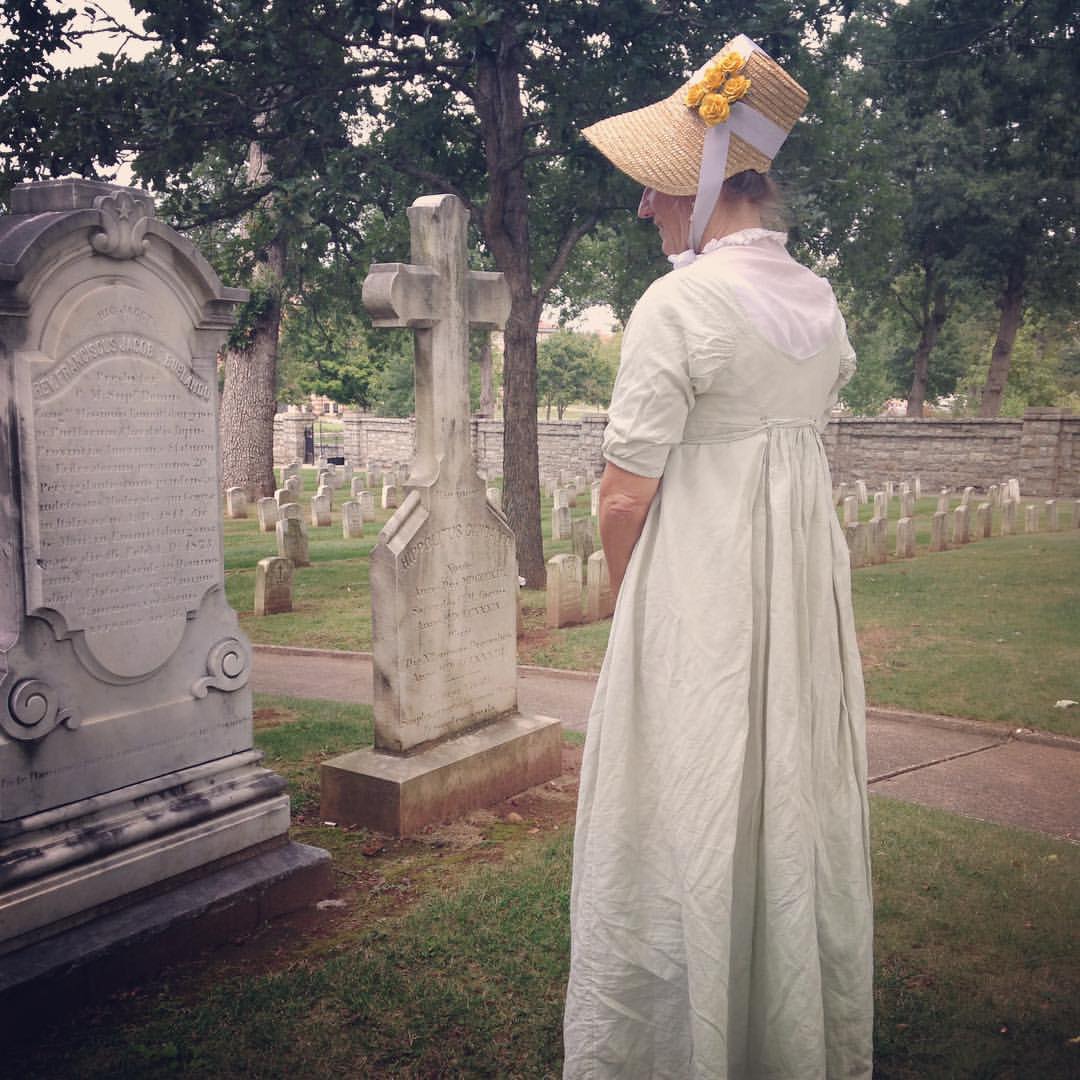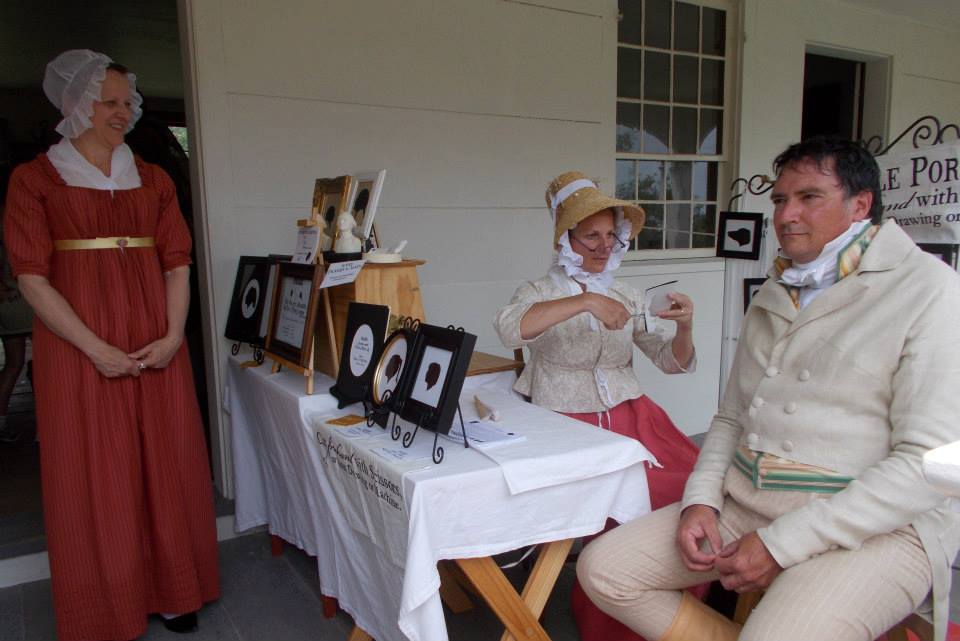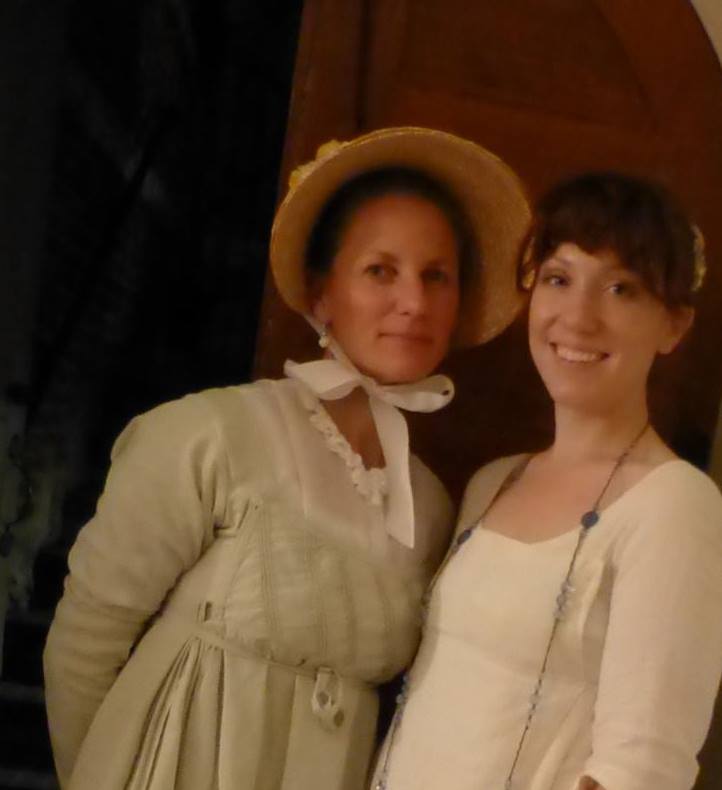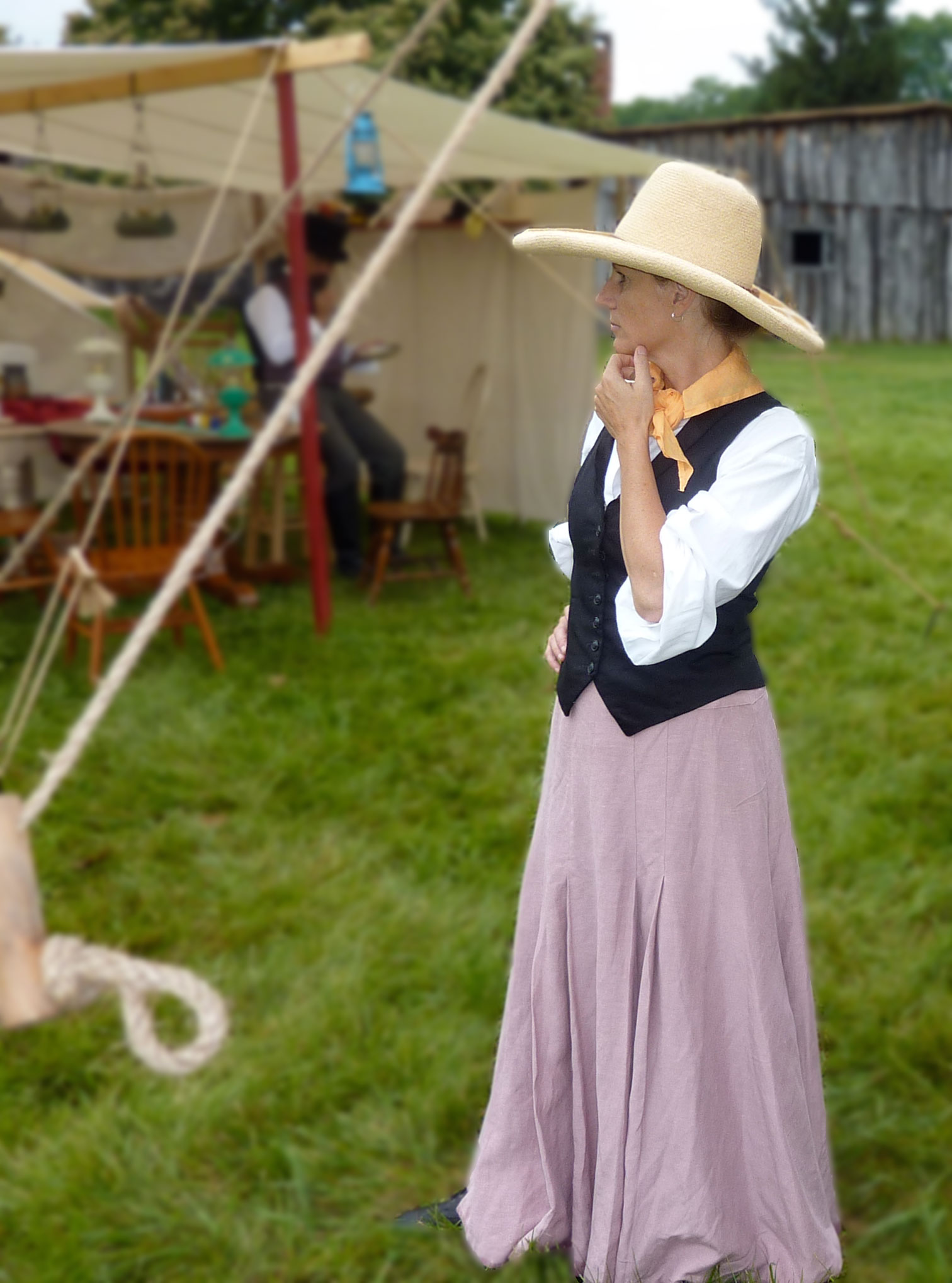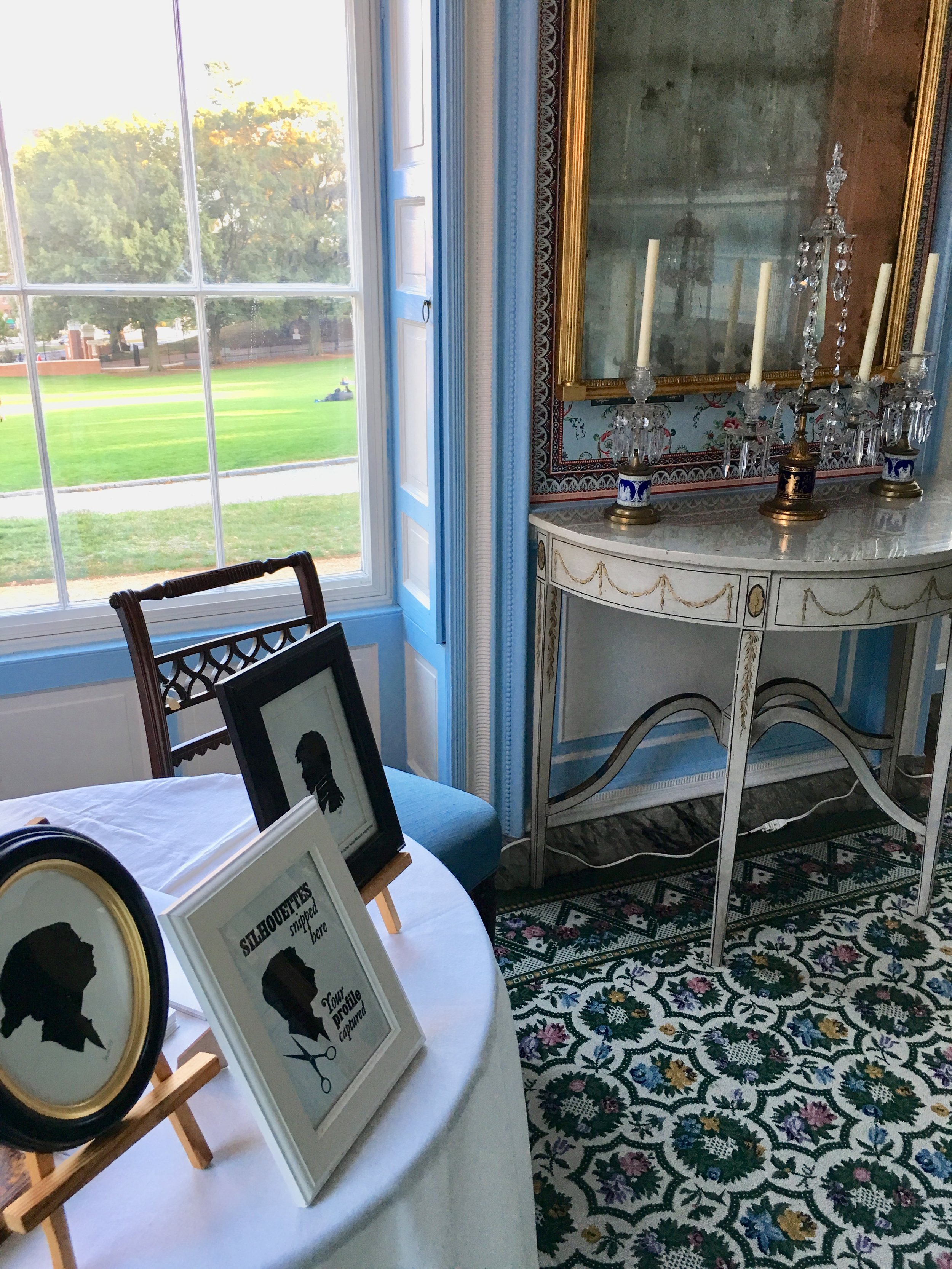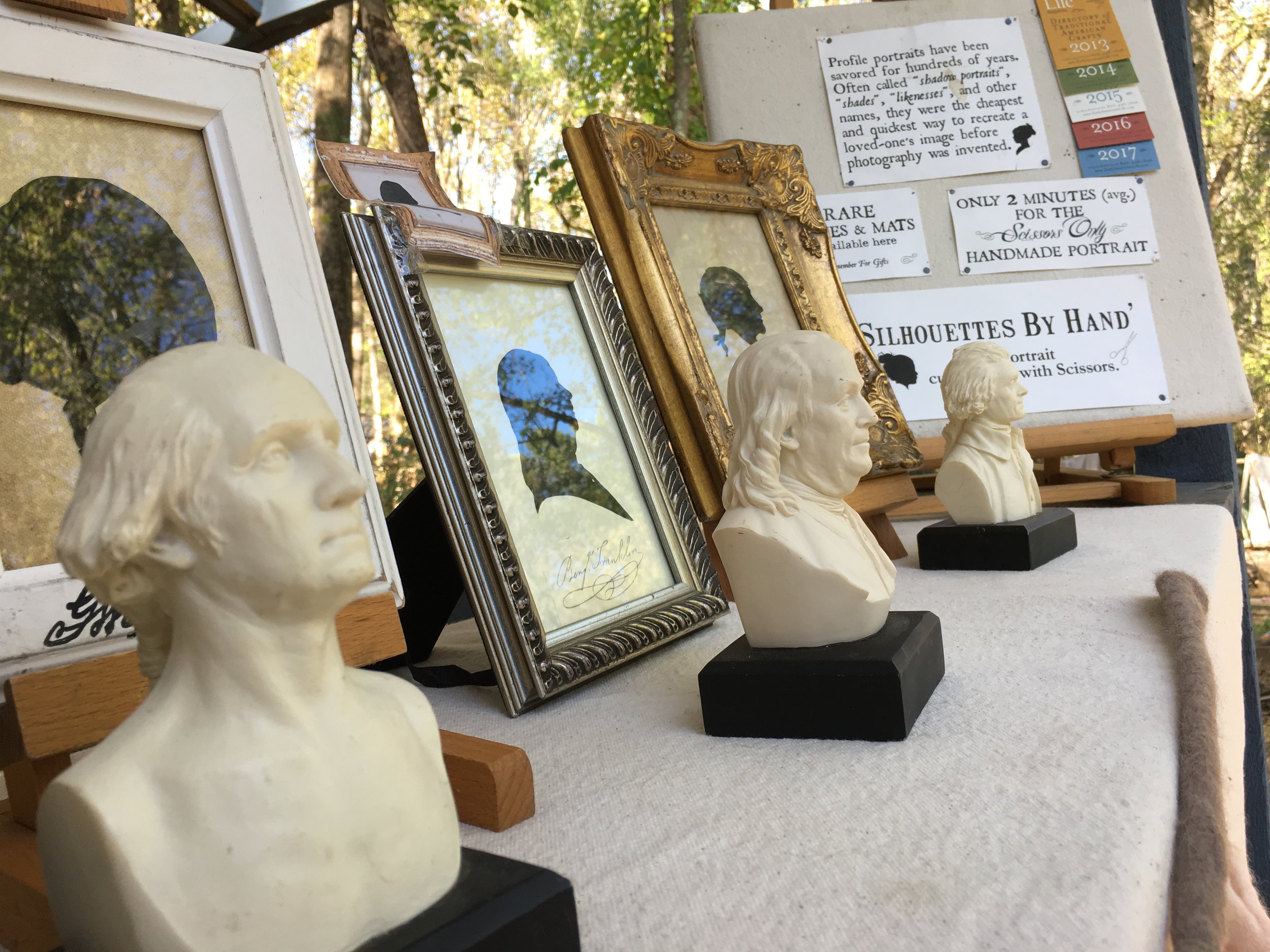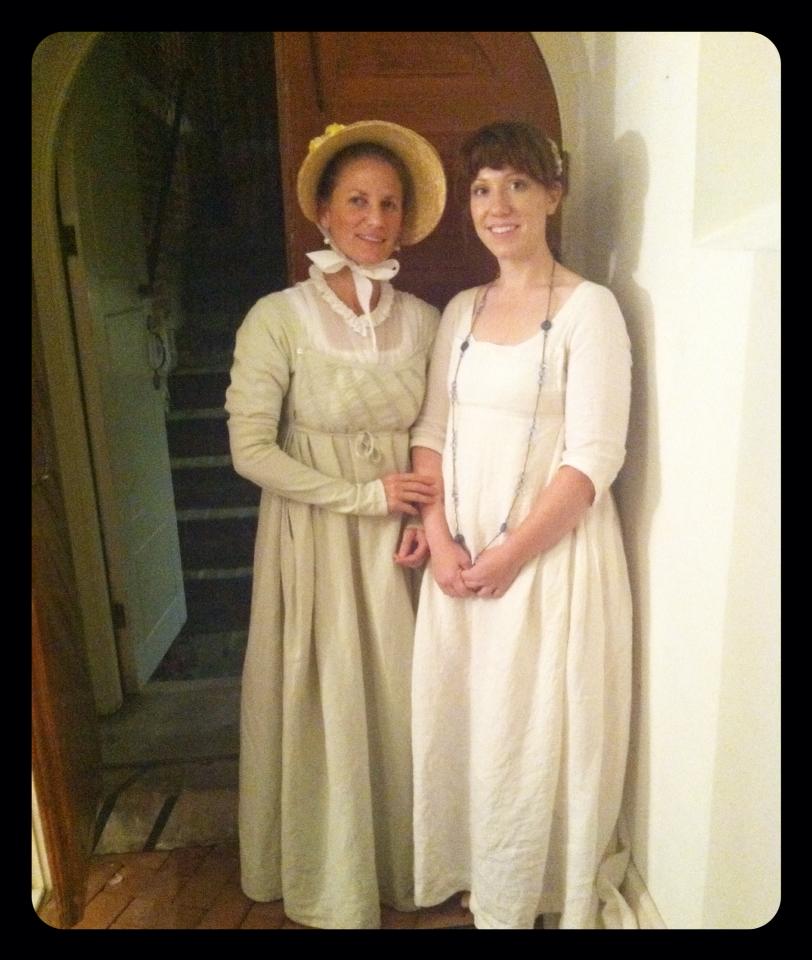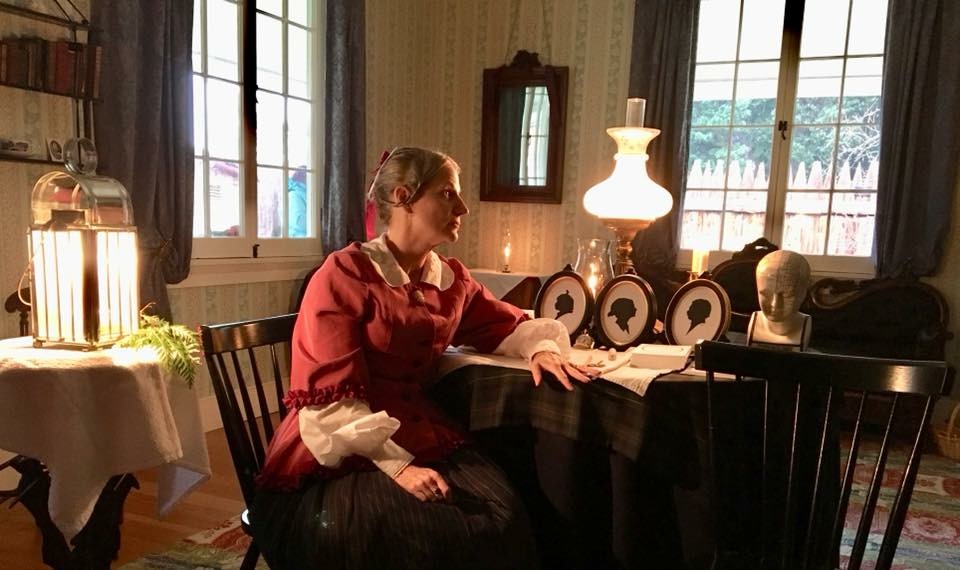Museums and Education
Silhouettes' history is the history of modern life.
Lauren Muney and Silhouettes By Hand specialize in presenting "living history", "experiential history" and demonstrating live for guests and visitors about this traditional, historical trade of silhouette portraiture; interpreting social, philosophical, and economic history during the silhouette-cutting experience.
Silhouettes By Hand specializes in fascinating discussion during silhouette portraiture. Lauren has done painstaking research not only into the authentic clothing but also the history and cultural details of these many eras. She has taught at centers of material culture to enthusiasts, historians, and conservators.
Please visit the History of Silhouettes overview to learn more about silhouettes through time.
Lauren Muney cuts silhouettes in the clothing of the American Revolution at Historic Londontowne Museum and Gardens, Londontown, MD
Living History
Or, engaging your guests in time
Lauren's favorite events to participate are museums, "villages", and/or interactive history events, whereby the visitors can feel like they have transported back in time themselves. They experience their silhouette as a ‘native’ of the time period, feeling immersed in the era and the complicated nuances of that time.
While there are only a handful of traditional freehand silhouette artists in the world, it is rare to find a silhouette artist who interprets history to the visitor at the same time, bringing the visitor closer with the heritage. All educational or museum facilities can create a public program with Silhouettes By Hand. Some example facilities are listed at the bottom of the Booking page.
Guest Benefits of silhouette portraiture at your event:
The guest receives a personal, interactive interpretative experience, focusing on that specific time period.
The guest sits for a freehand-scissored profile portrait, experiencing this historical portrait form in less than 3 minutes for the scissoring.
The guest, now a participant, connects deeper with the culture and feelings of the period, deeper than an observer's viewpoint.
The guest takes home his or her portrait to remember themselves 'time-traveling'.
The guest remembers their enjoyment of the facility and the event.
Museum/Facility Benefits of silhouette portraiture at your event:
The facility creates and develops a new event to capture the community's attention, imagination, and communication ("buzz"). This can entice new and returning visitors to the facility.
The community and guests who visit the silhouette 'station' (and presentations) are enveloped in deeper interactivity than traditional interpretative tours.
Good-publicizing facilities can (and should) create a media event before, during, and after the silhouettes visit, increasing publicity and increasing revenue.
Silhouette portrait keepsakes connect the visitor to the facility, both in the visior's home and in networking with friends and loved ones.
Grants can pay for this visit, whether for Traveling Artist (Visual or Performance), or Humanities grants
Presentations
Lauren Muney can present on the history of silhouettes, using historical images, stories, and humor. This presentation runs approximately 45 mins. This presentation can include silhouette portraiture afterwards.
Lauren Muney is shown here presenting at the American Philosophical Society in Philadelphia, PA, in coordination with their exhibit "Curious Revolutionaries “ exhibition (2017)
Physiognomy
("reading" personality from facial features):
Physiognomy was popular for thousands of years before real science overtook the belief "sciences". Lauren can present Physiognomy in a presentation, casual or even a group-engagement format. Read more in this page.
Drawing by Petrus Camper, 1722-1789
Time Periods:
Scroll down for an interesting list…
(Leaving the 21st century for a little time-travel with you!)
While there wasn’t a presence of cut paper silhouettes in the late Tudor / Renaissance eras, there were profile portraits in paintings, and the burgeoning “science” of physiognomy certainly focused cultural attention on facial features.
As Lauren is a guest artist at the highest-rated Renaissance Festival in the United States, this era is placed in this line-up of time periods represented by her silhouettes. She uses her museum skills to engage and delight events of all eras.
Late Tudor /Renaissance:
During the late 1700s, this era featured the growth of the United States, Canada, and the continuing expansion of the English reach. Authentic clothing includes correct natural fibers, period-correct undergarments such as stays, stockings, period-correct shoes, and hats. The people ranged from rustic to rich, and the attitudes, objects, and clothing reflected the variations in the culture.
Starting in the 1770s in Germany, the 1780s in England, and the 1790s in the new USA, silhouettes became a part of the new culture. In Germany there was a royal court silhouettist in Berlin, and silhouettes stayed upper-class. In the English speaking lands, the wealthy (“better sort”) had portraits painted, the small middle class (“middling sort”) could only afford silhouettes as portraits, while the poor class (“lowest sort”) could afford nothing but bare subsistence.
Traveling artists would create demand for their services by placing ads in newspapers or posting broadsides in advance of their arrival into towns. The main locations for silhouette services seemed to be at the place of accommodations (often a tavern).
It is in the 1760s-1780s that brought the societal changes which created the new United States. 1776 brought the final culmination of threats between the Colonies and Britain; independence was declared and the war was on.
Colonial, into Revolutionary (1730-1780s):
Federal and Regency, into War of 1812 (1790-1815)
This was the real self-discovery of the new United States, and a period of decadence (not to mention confusion) in Britain. The American government sought to define itself and also to understand its place in the world. During this English Regency and American Federal periods, women’s clothing featured high waistlines, long “column” dresses, and bonnets or hair buns – a reflection of the “rediscovery” of the Greek and Roman culture, “neoclassicism”.
It is during this period that silhouettes had their most favored status, due to the excitement of physiognomy (determining character by facial features), and possibly the new commercial options due to expanded trade routes, American self-reliance, and new inventions.
It was during this era that face-tracing machines (physionotrace devices) were invented, patented, and became favored for silhouettes due to their newfangled machine appeal. Physionotrace operators vied with one another for public attention and profit.
True artists with machines could make a name for themselves but only if their resulting product reached the correct social strata. Read more about this era in Lauren’s peer-reviewed paper Itinerant Artists: Portraiting Early America with Scissors, Soot and Beer
Antebellum, Victorian, and Industrial Revolution (1830-1900 )
The names of this era become a little confusing because the Victorian period extended for over 60 years. This was an era of new industrial developments, social improvements, and even new home improvements. The people went through boom and bust periods. Photography became less expensive as this era moved forward, becoming less novelty and more commonplace - and less expensive than its early days.
During these eras, which can loosely be described from around 1830 well into the early 1900s, show some of the most romantic and iconic women’s clothing: varying widths of sleeves and skirts, enlarging petticoats and hoops, dropping waistlines, new booties, corsets, hats or bonnets, and tucked hair.
Photography was invented during time period, although it was still in limited use until it became more inexpensive towards the latter 19th century; silhouettes were waning for common people for many reasons. During these decades, Harvest and other community Fairs have great enthusiasm and importance for silhouettes, upkeeping this now-familiar tradition with the more rural communities.
There were many social and economic impacts throughout the United States during this time, deeply shown by the rift of the war. However, not every continent was burdened by a major war; many countries were enjoying growth and development during this era.
During this era photography was introduced to the public in a broader way, thanks to the traveling photographers who took photos before and after the battles.
During this era,women’s clothing featured full hoops and yards of fabric, bonnet and hats, and sometimes there was a stark difference between the rich and poor. Bodies were quite covered while people struggled to cover ‘rudeness’.
American Civil War (1861-1865)
The American West brings both cowboys and “fancy folks” looking to enjoy the benefits of the new opportunities. There was a vast excitement in traveling, moving West, creating new ideas and cities.The frontier was open to those willing to do hard work under difficult circumstances.
Silhouettes were on the wane, but not lost entirely - there were still seen at agricultural fairs and other rural social occasions.
Opening of the West (1870-1880)
The “Steampunk” era (think: Jules Verne stories and inventions) imagines a time when steam created all engines towards a modern time-journey; Victorian design combines with science fiction.
“Steampunk” (1870-1900)
The new century was very exciting, both to celebrate the new and to be nostalgic about the old. While some people embrace new inventions such as the automobile, others look backward at the ‘old style’ handmade artist work. The excesses of the industrial age made silhouettes return to the streets, Worlds Fairs, social events, community events, hotels, and resort locations. Chautauquas, or adult summer camps for the arts and sciences, brought new attention to the personalized and artistic.
Turn of the century, Edwardian, WWI (1900-1920)
In today’s busy world, black tie or other festive dress can be a entertaining as a set of clothing from the past. Classic vests, bowtie, flirty skirts or designer dresses – most modern theme requests can easily be accommodated, showing off this classic portrait form to delighted visitors and guests.
Modern Day
What People Are Saying
“We want want to also extend a huge thank you for the delightful program. We are so happy that you were able to come up to Philadelphia and our tiny (but mighty) museum to discuss the history and craft of silhouettes. The guests who attended left raving about the lecture and those who were lucky enough to get a silhouette were so captivated by the experience. ”
“Your contributions to our event were very well received and we are glad to have had such a talented artist and presenter as a special element during Holiday Nights. We look forward to more opportunities ahead and thank you again for your warm presence and a wonderful show. ”
“We can’t thank you enough for bringing “Silhouettes By Hand” to our historic house and farm, creating such lasting memories for our visitors and volunteers. Your period-correct attire, wonderful manner with people of all ages and backgrounds, and masterful presentation of an art form perfect for the times we portray, made for a truly special Valentine’s Day program. The portraits were superb!”
“Your services and warm demeanor really increased the quality of [our 19th Century Christmas] event! ”
History, through silhouettes
FAQs
(Frequently asked questions!)
“How do I get a quote for my event?”
Send an email through the contact form! Give as much information as possible so your artist can give you a custom proposal based on your event description, location, date and time of your event. Your price-proposal may contain travel fees if you are outside your artist’s local area. Your proposal will include all details what your event will provide for the artist, and what your artist will provide for your event.
“Can I make a custom plan to use silhouettes?”
Of course! your artist Lauren Muney loves creating a interesting engagement for your visitors or guests. The more creative, the better! Your quote will include how your guests will be engaged.
“Can you fit into my museum’s time period?”
Lauren’s clothing spans several centuries, butshe cannot cover every year of 400 years of North American history.. If you have location- or year-specific clothing for your museum, you might have to either allow Lauren’s current clothing to fit your era, or let her borrow your era’s clothing for the perfect match.
“How does payment and contracting happen?”
Paying your artist Lauren Muney happens through her secure online payment systems, using one or more possible payment methods including: credit card, ACH (checking account), direct payment systems like Paypal, Bill.com, and in some cases, wire transfer. Depending on how far in advance you are booking, you may be paying a deposit or the entire amount to hold your date. The arrangements are very clear and fair. The invoice becomes the contract, or we may negotiate a custom contract.
“How many silhouettes can you cut per hour?”
Depending on the event, situation, and the guests, Lauren can cut 12-18 detailed, elegant silhouettes per hour, each with amazing likeness to the guest. This is faster than other live portrait artists, and more engaging with participating guests than other party options!
“Will you do a presentation about silhouettes?”
Yes, your artist Lauren Muney has been researching silhouettes history for almost 20 years - she was even a fellow at the prestigious Colonial Williamsburg Foundation, and wrote a paper about part of the material culture of silhouettes. Just ask Lauren to help plan your custom presentation to your guests.
“What is the setup for silhouettes?”
Your setup is custom to your event. Most often, you may be providing a safe dry area, away from sun and wind. You may provide table with chairs, or Lauren may bring her own. Whatever your event, Lauren will help you customize the setup to use silhouettes well with your particular event , setup, and situation.
“How far will you travel to cut silhouettes?”
Your artist Lauren Muney has traveled around the world or around the corner to cut silhouettes! “Have scissors will travel”.
